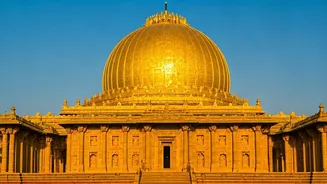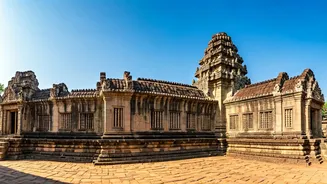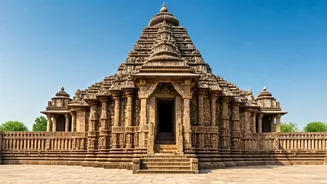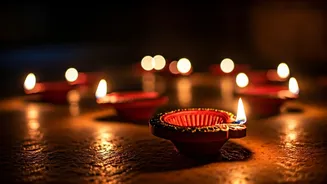Konark Sun Temple
The Konark Sun Temple, a UNESCO World Heritage site located in Odisha, stands as a stunning example of Kalinga architecture. Built in the 13th century,
it's designed in the shape of a colossal chariot, with intricately carved wheels and horses. The temple is dedicated to the sun god, Surya, and its sculptures depict various aspects of life, including both worldly and divine scenes. A visit to Konark is not just a sightseeing trip; it’s an immersion into India's artistic brilliance and the stories of its ancient civilizations. The temple’s symbolism is deeply rooted in Hindu mythology, reflecting the sun's journey across the sky. The sheer scale and detail of the carvings, from the figures of musicians and dancers to the celestial beings, tell the tales of an era when art and spirituality were intertwined. The temple’s strategic positioning, allowing the sun's rays to fall directly on the deity at dawn, further illustrates the importance of the sun god in the lives of the people who built it.
Modhera Sun Temple
In Gujarat, the Modhera Sun Temple is a striking example of the Maru-Gurjara style of architecture, dating back to the early 11th century. This temple is unique for its stepped tank, known as the 'Surya Kund,' adorned with numerous sculptures and intricate carvings. The main temple structure is equally impressive, with detailed depictions of deities, celestial figures, and scenes from the epics. The architecture of the Modhera Sun Temple displays a mastery of geometrical patterns and precision. This reflects the importance of astronomy and celestial observation in ancient Indian culture. Visiting Modhera offers a glimpse into the sophisticated understanding of art and architecture, and showcases a rich cultural heritage. The temple's design beautifully harmonizes with the surrounding landscape, providing a serene environment for reflection and contemplation. Despite the damage suffered over time, the temple's enduring beauty and significance continue to draw visitors and researchers from around the world.
Martand Sun Temple
The Martand Sun Temple, located in Jammu and Kashmir, stands as a grand reminder of the region's rich history. Built by the Karkota dynasty in the 8th century, it features a blend of Gandharan, Gupta, and Chinese architectural styles. The temple's central structure, surrounded by a courtyard and numerous smaller shrines, highlights its impressive scale. Though partially in ruins, the Martand Sun Temple still conveys a sense of power and beauty, illustrating the ingenuity of its builders. The temple’s location in the scenic Kashmir Valley provides an extraordinary backdrop, allowing visitors to connect with the past while surrounded by natural beauty. The temple's intricate carvings and grand layout suggest the importance of the sun god, Surya, in the region's religious and cultural practices. The ruins bear testament to the resilience of art, architecture, and the human spirit that have transcended through the centuries.
Surya Pahar Temples
The Surya Pahar Temples in Assam are a cluster of ancient temples dedicated to the sun god. These temples are known for their rock-cut sculptures and are a significant site for religious pilgrimage. The site's archaeological remains indicate a deep connection with both Hinduism and Buddhism. The presence of these different religious influences signifies the spiritual openness that characterized ancient India. This location gives insights into the religious practices that blended together and shows the diverse religious landscape of the time. The Surya Pahar temples allow visitors to explore the evolution of religious beliefs and how they influenced art, architecture, and societal structures. These sites serve as a window into the past, offering a rich exploration of the syncretism that characterized ancient Assam. The site's significance extends to the architectural designs and the stories of the people who worshiped there.
Other Notable Temples
Apart from the above mentioned temples, many other locations in India also share a significant association with the worship of the sun. These include the intricate structures and detailed artwork in various parts of the country. Exploring these places provides a more in-depth knowledge of solar veneration. Visiting these locations offers a great chance to travel in time and experience the historical and cultural development that shaped ancient India. This will also give you an appreciation of how the sun, as a source of energy and life, was honored in diverse ways across different regions. Learning about these less famous sites, along with the major ones, offers a wider and richer image of India's spiritual and artistic heritage. They showcase the variety and flexibility of religious beliefs and practices, all united by a common respect for the sun.












